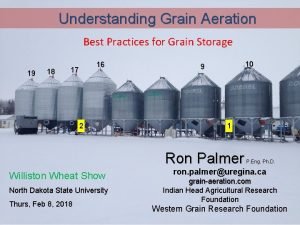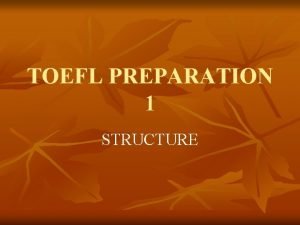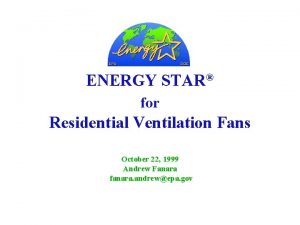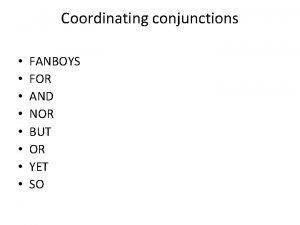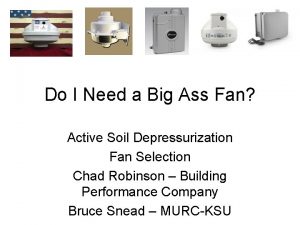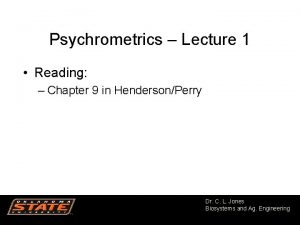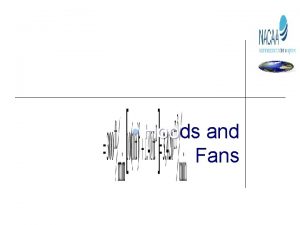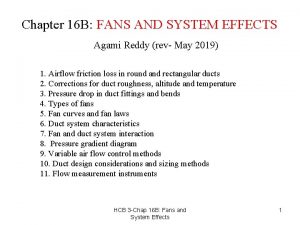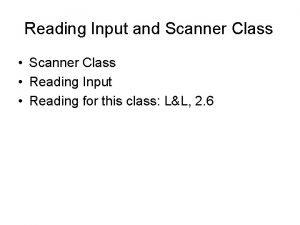Fans Part 1 Reading Chapter 5 in HendersonPerry
























- Slides: 24

Fans Part 1 • Reading: – Chapter 5 in Henderson/Perry – Greenheck Product Application Guide – Dwyer Manometer Guide – AMCA Fan Curve Guide BAE 2023 Dr. C. L. Jones Biosystems and Ag. Engineering 1

Pumps, Fans, Compressors-Turbomachines • Turbomachines: change energy level of flowing fluid by means of momentum exchange • Wide spread in ALL industries – – – – Power units: cars/trucks, tractors Computers Grain elevators Oilfield Medical facilities Food processing And……. BAE 2023 Dr. C. L. Jones Biosystems and Ag. Engineering 2

Pumps, Fans, Compressors— Turbomachines (Review) • Differences between pumps, fans, compressors – Pumps: move liquids – Fans: move gases with little increase in pressure – Compressors: move gases with greater increase in pressure BAE 2023 Dr. C. L. Jones Biosystems and Ag. Engineering 3

Fan Standards • ASHRAE: American Society of Heating, Refrigeration, and Air conditioning Engineering…research and standards • AMCA: Air Movement and Control Association…standards BAE 2023 Dr. C. L. Jones Biosystems and Ag. Engineering 4

Fan Operation • Fans cause pressure increase by: – Centrifugal force created by rotation of the column of air trapped between two blades – Kinetic energy is supplied to the air through the impeller – Total pressure = velocity head + static pressure BAE 2023 Dr. C. L. Jones Biosystems and Ag. Engineering 5

Selection Considerations • Quantity of air to be moved per unit time • Estimated system resistance and expected variations • Amount of noise permitted • Space available for fan • Economic implications BAE 2023 Dr. C. L. Jones Biosystems and Ag. Engineering 6

Fan Classification • Designated as dynamic pumps – Centrifugal • Further classification by entry and exit of fluid/gas through impeller • 4 aerodynamic classifications: – – Axial flow Radial flow : referred to as “centrifugal fan” Cross flow Mixed flow BAE 2023 Dr. C. L. Jones Biosystems and Ag. Engineering 7

Axial-flow Fans • Propeller • Tube-Axial • Vane-Axial BAE 2023 Dr. C. L. Jones Biosystems and Ag. Engineering 8

Propeller Fans • Used in many agricultural ventilation applications with free delivery or low pressure conditions • Propeller has a pitch (twist). Distance of air travel depends on pitch and # of blades • Warping the blades prevents back flow of air (page 121) BAE 2023 Dr. C. L. Jones Biosystems and Ag. Engineering 9

Tube-Axial Fans • Wheel or impeller within a tube • Blades are warped for efficiency • Operates at higher pressures and higher ME than propeller fans BAE 2023 Dr. C. L. Jones Biosystems and Ag. Engineering 10

Vane-Axial Fans • Like a tube axial with guide vanes before or after the impeller • Higher pressures and efficiencies ( up to 2200 psi and 85% +) because… • Vanes direct air flow through a gradual turn until tangential velocity component is eliminated BAE 2023 Dr. C. L. Jones Biosystems and Ag. Engineering 11

Centrifugal Fans • Consists of wheel or rotor within a spiral housing • Air makes a 90 degree turn • Forward-curved-tip • Backward-curved-tip • Straight or radial tip BAE 2023 Dr. C. L. Jones Biosystems and Ag. Engineering 12

Straight or Radial-Tip Fans • • 6 – 20 blades Blades are 2 to 3 x as long as they are wide Larger housing, more expensive Can handle dirty air and higher pressures BAE 2023 Dr. C. L. Jones Biosystems and Ag. Engineering 13

Backward-Curved-Tip Fans • Approx. 12 blades • Flat and tilted backwards • High speed fan with self-limiting power – If sized correctly, motor won’t overheat if conditions change (curve pg. 132) • Most efficient • Cannot handle dirty air BAE 2023 Dr. C. L. Jones Biosystems and Ag. Engineering 14

Forward-Curved-Tip Fans • • Up to 60 blades Narrow radially but wide parallel to shaft Face forward in direction of rotation, scoop Low-speed, moderate pressures, can be unstable • Clean air only • Lowest noise!!!!! • Used in many furnace blowers BAE 2023 Dr. C. L. Jones Biosystems and Ag. Engineering 15

Cross-Flow (or Tangential) Fans • Uniform discharge, high air rate • Use in ovens, baseboard heaters, unit heaters, drying equipment, kitchen hoods • Larger housing, more expensive • Can handle dirty air and higher pressures BAE 2023 Dr. C. L. Jones Biosystems and Ag. Engineering 16

Mixed-Flow Fans • Aka In-line or Tubular Centrifugal fans • Combines features of centrifugal and vaneaxial fans • Straight-through air flow but performance characteristics of centrifugal • Quiet like centrifugal • Used as exhaust fans in homes, commercial and agricultural BAE 2023 Dr. C. L. Jones Biosystems and Ag. Engineering 17

Performance • Tested at shutoff and free delivery conditions • Shutoff: discharge is blanked off • Free delivery: outlet resistance is 0 BAE 2023 Dr. C. L. Jones Biosystems and Ag. Engineering 18

Fan Curves • Manufacturer provides fan curve • Predicts the pressure-flow rate performance of each fan • Choose fan according to volumetric flow rate for your system pressure drop • Choose fan with peak efficiency at or near your operating point • Sometimes manufacturers use tables instead (Greenheck Handout) BAE 2023 Dr. C. L. Jones Biosystems and Ag. Engineering 19

Fan Curves • Fans follow the affinity laws (ASHRAE) BAE 2023 Dr. C. L. Jones Biosystems and Ag. Engineering 20

Fan Law Example • Fan speed N changes from 600 to 650 rpm for a fan of a given size BAE 2023 Dr. C. L. Jones Biosystems and Ag. Engineering 21

Fan Curves • If we know static pressure and outlet area, we can find total pressure: • Total pressure includes static and velocity pressure • If we know power, static efficiency, or total efficiency, the others can be calculated: BAE 2023 Dr. C. L. Jones Biosystems and Ag. Engineering 22

Sound Power Levels • Energy transfer • In d. B: Sound • W 0 = 1 x 10 -12 Watts • W = power (W) • For additional units, see eqtn. 5. 6 (H/P) • Sones: One sone represents the loudness of a 1 k. Hz tone at 40 d. B SPL. BAE 2023 Dr. C. L. Jones Biosystems and Ag. Engineering 23

More Fans… • Fans in parallel: moves curve to the right… pressure stays the same, flow rate is the sum • Fans in series: moves curve up… flow rate stays the same, pressure is the sum BAE 2023 Dr. C. L. Jones Biosystems and Ag. Engineering 24
 While reading activities
While reading activities Best time to run fans to aerate grain
Best time to run fans to aerate grain Global climate is warming has been well documented
Global climate is warming has been well documented Fans 1/a coverage map
Fans 1/a coverage map Anahaw fan
Anahaw fan Residential ventilation fans market
Residential ventilation fans market Encon cooling tower
Encon cooling tower Animals with ears like leaves
Animals with ears like leaves Fans navigation
Fans navigation Nor fanboys
Nor fanboys Fans singular or plural
Fans singular or plural Oonly fans
Oonly fans Fans blowers and compressors
Fans blowers and compressors Fan blowers & compressors
Fan blowers & compressors Examples of onomatopoeia in romeo and juliet
Examples of onomatopoeia in romeo and juliet Alluvial cone
Alluvial cone De strat fans
De strat fans Big ass prof
Big ass prof Powerhousepc
Powerhousepc Part part whole addition
Part part whole addition Unit ratio definition
Unit ratio definition Part part whole
Part part whole Technical description
Technical description Parts of a bar club
Parts of a bar club The part of a shadow surrounding the darkest part
The part of a shadow surrounding the darkest part

